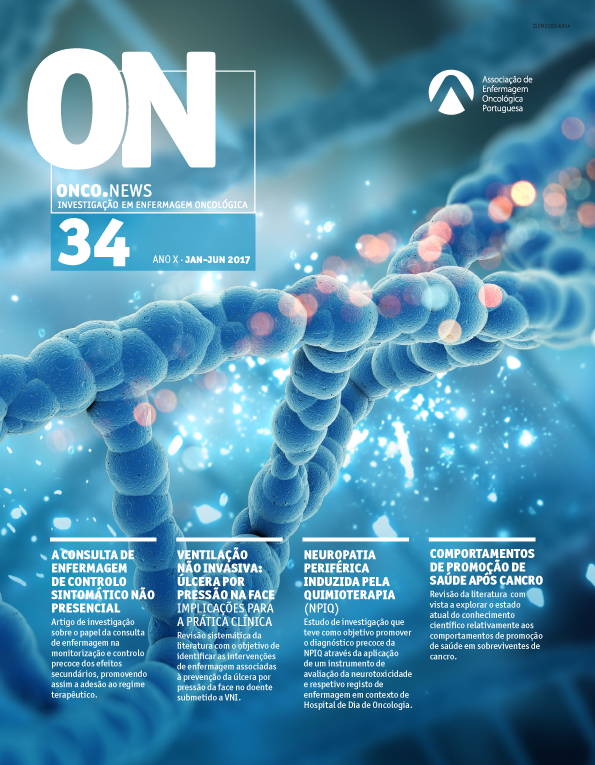Non-invasive ventilation: pressure ulcer on the face - implications for clinical practice
Keywords:
Non-invasive Ventilation, Nursing Interventions, Mask / Interface, SkinAbstract
The non-invasive ventilation (NIV) represents a major evolution in the approach of respiratory failure. The nursing interventions during NVI are often a challenge for the team, since the care adaptation is focused in the individuality of each and every person. Based on available scientific knowledge there are complications associated with NIV, being the one related with interface – pressure ulcer the most serious. The nursing interventions are directed to the patient evaluation and action planning respecting the guidelines for clinical practice. With the goal of identifying the nursing interventions associated with the prevention of the face pressure ulcer in the patient undergoing NIV was developed a systematic review of the literature. For the development of this article were selected 8 full-text articles with time interval from January 2011 to March 2016 from the electronic databases CINAHL (The Cumulative Index to Nursing and Allied Health Literature), Nursing & Allied Health Collection, and MEDLINE. We used the method PI[C]O and selected 8 articles from a total of 150. The NIV has taken on a particular importance as a strategy in the treatment of the patient with respiratory pathologies and it should be based on whether there is a prospect of reversibility or, in case of end stage cancer patients, in patient’s comfort including dyspnoea improvement and maintaining autonomy. The ulcer due to face pressure emerges as the most serious y recurrent complication in every study. Nurses should prioritize an evaluation and a continuous
surveillance, the fit of the mask, switching between mask types, the choice of model and proper sizing, the application of the right amount of pressure, the repositioning, the hygiene and skin hydration. The nursing intervention is decisive in preventing and minimizing the complications, promoting safe and quality care.
Downloads
References
Landoni, G. (2012). Noninvasive ventilation after cardiac and thoracic surgery in adults patients: a review. Journal of Cardiothoracic and vascular anesthesia, 26.
Fortin, M. (2009) - Fundamentos e Etapas do Processo de Investigação. Loures: Lusodidacta.
Melnyk, B. M. & Fineout-Overholt, E. (2011). Evidence-based practice in nursing and healthcare: A guide to best practice. Philadelphia: Lippincott, Williams & Wilkins.
Soares, A. (2014). Intervenções de Enfermagem ao Cliente Submetido a Ventilação Não-Invasiva no Serviço de Ur-gência. Dissertação de Mestrado. Instituto Politécnico de Setúbal. Portugal.
Chacur, F.; Vilella F.; Fernandes, C. & Lazzarini, L. (2011). The total face mask is more comfortable than the oronasal mask in noninvasive ventilation but is not associated with improved outcome. Respiration; International Review Of Thoracic Diseases, 82(5), 426-430. doi:10.1159/000324441. Available from: CINAHL Complete
Disponível em: http://search.ebscohost.com/login.aspx?direct=true&db=ccm&AN=104703195&lang=pt-br&site=ehost-live (9 mar 2016)
Schallom, M. et al (2015). Pressure Ulcer Incidence in Patients Wearing Nasal-Oral Versus Full-Face Noninvasive Ventilation Masks. American Journal Of Critical Care: An Official Publication, American Association Of Critical-Care Nurses, 24(4), 349-356. doi:10.4037/ajcc2015386. Available from: MEDLINE Complete;
Disponível em: http://search.ebscohost.com/login.aspx?direct=true&db=mdc&AN=26134336&lang=pt-br&site=ehost-live (9 mar 2016).
Liu; J.; Duan J., Linfu Bai, M. & Zhou, L. (2016). Noninvasive Ventilation Intolerance: Characteristics, Predictors, and Outcomes. Respiratory Care. March; 61(3). DOl: 10.4187/respcare.04220. Available from: MEDLINE Complete
Disponível em: http://search.ebscohost.com/login.aspx?direct=true&db=mdc&AN=26715769&lang=pt-br&site=ehost-live (9 mar 2016).
Kwok, H.; Mccormack, J.; Cece, R.; Houtchens, J. & Hill, N. (2003). Controlled trial of oronasal versus nasal mask ventilation in the treatment of acute respiratory failure. Crit Care Med; 31(2):468-473.
Femandez-Vivas, M.; Caturla-Such, J.; Gonzalez de la Rosa, J.; Acosta-Escribano, J.; Alvarez-Sanchez, B. & Canovas-Robles, J. (2003). Noninvasive pressure support versus proportional assist ventilation in acute respiratory failure. Intensive Care Med; 29(7):1126-1133.
Ahmad, Z. .; Venus, M.; Kisku, W. & Rayatt, S. (2013). A case series of skin necrosis following use of non invasive ventilation pressure masks.
International Wound Journal, 10(1), 87-90. doi:10.1111/j.1742-481X.2012.00948.x. Available from: MEDLINE Complete
Disponivel: http://search.ebscohost.com/login.aspx?direct=true&db=mdc&AN=22432901&lang=pt-br&site=ehost-live (9 mar 2016)
Belchior, I.; Gonçalves, M. & Winck, J. (2012). Continuous noninvasive ventilation delivered by a novel total face mask: a case series report.
Respiratory Care, 57(3), 449-453. doi:10.4187/respcare.01275. Available from: MEDLINE Complete
Disponível: http://search.ebscohost.com/login.aspx?direct=true&db=mdc&AN=21968352&lang=pt-br&site=ehost-live (9 mar 2016).
Souto Barros, L.; Talaia, P.; Drummond, M & Natal-Jorge, R. (2014). Facial pressure zones of an oronasal interface for noninvasive ventilation: a computer model analysis. Jornal Brasileiro De Pneumologia: Publicaçao Oficial Da Sociedade Brasileira De Pneumologia E Tisilogia, 40(6), 652-657. doi:10.1590/S1806-37132014000600009 Available from: MEDLINE Complete; Disponível em: http://search.ebscohost.com/login.aspx?direct=true&db=mdc&AN=25610506&lang=pt-br&site=ehost-live (9 mar 2016).
Mourisco, S. (2006). Complicações da Ventilação Mecânica Não-Invasiva. Nursing. Lisboa. - ISSN0871-6196. Outubro, 16( 214); 49-50
Wellington, P.; Yamaguti, P.; Moderno, E.; Yamashita, S.; Gomes, T.; Maida, A.; Kondo, C.; Salles, I. & Brito, C. (2014). Treatment-Related
Risk Factors for Development of Skin Breakdown in Subjects With Acute Respiratory Failure Undergoing Non invasive Ventilation or CPAP. Respir Care; 59(10):1530—1536. DOI: 10.4187/respcare.02942. Available from: MEDLINE Complete Disponível em:
http://search.ebscohost.com/login.aspx?direct=true&db=mdc&AN=24894664&lang=pt-br&site=ehost-live (9 mar 2016
Bachour, A.; Vitikainen, P.; Virkkula, P. & Maasilta, P, (2013). CPAP interface: satisfaction and side effects. Sleep Breath, July, 17(2):667–672, DOI 10.1007/s11325-012-0740-0.Availabe from: MEDLINE Complete
Disponivel:http://search.ebscohost.com/login.aspx?direct=true&db=mdc&AN=22763499&lang=p br&site=ehost-live (9 mar 2016).
Ordem dos Enfermeiros (2009). Padrões de qualidade dos Cuidados de Enfermagem: Enquadramento Concetual, Enunciados descritivos.
Lisboa: Ordem dos Enfermeiros.
Hesbeen, W. (2001). Qualidade em enfermagem - pensamento e ação na perspetiva do cuidar. Loures: Lusociência. ISBN: 972-8383-20-7
Gonçalves, R. (2011). Cuidados de enfermagem com a interface. In António M Esquinas Princípios da ventilação mecânica não invasiva. Gasin Medica Grupo Air Products: 435-442.
Downloads
Published
How to Cite
Issue
Section
License
Copyright (c) 2022 Cristina Grilo , Sílvia Alminhas

This work is licensed under a Creative Commons Attribution-NonCommercial-ShareAlike 4.0 International License.




